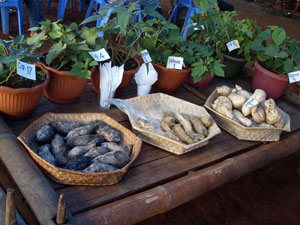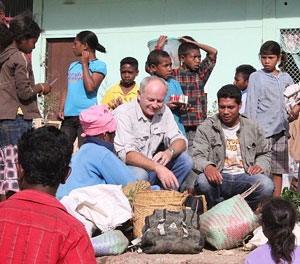East Timor has three seasons: a dry season, wet season and a hungry season. For the East Timorese, the hungry season literally means many go hungry for up to five months of the year.
In East Timor, a country where up to 85 per cent of the population relies on traditional farming, one in two people don't have reliable access to food or are food insecure. Crops often produce low-yields or fail entirely because of the weather or natural disasters. After harvest, crops are frequently lost to weevils, mould and rodents, or farmers simply can't get their produce to market because of poor roads or limited access to transport.
East Timor is also one of the poorest countries in the world. It continues to suffer from its decades-long independence struggle against Indonesia. This only compounds the problem of food security, especially when many cash-strapped East Timorese simply can't afford to buy food.
On average, each rural household in East Timor farms a little less than a hectare of land, often on a steep slope. With limited access to pesticides and machinery, they are only able to farm the area of land they can weed by hand. Maize, sweet potatoes, peanuts, cassava and rice are the main crops which are usually harvested using the customary katana, a large knife.
But such traditional farming techniques are inadequate. A hectare of land currently doesn't produce enough cereal to last a family for a year. With one of the highest fertility rates in the world, 7.5 children per woman, there is extra pressure on the young nation to find long-term solutions to feed its rapidly growing population.
Research to help find crops that produce more food started back in 2000, soon after East Timor's historic 1999 referendum for independence. The Australian Centre for International Agricultural Research (ACIAR) funded Seeds of Life to support the research.
From 2000 to 2005, the program focused on trialling different crops at a number of research sites around the country. Based on promising results, the Australian Agency for International Development (AusAID) joined ACIAR to fund the expansion of research and seed production from 2005 to 2010. This also saw the Seeds of Life program integrated into the East Timor Ministry of Agriculture and Fisheries.
Seeds of Life has developed two major research stations–a 22 hectare site on the south coast at Betano and a 21 hectare site on the north coast at Loes–where varieties of rice, maize, peanuts, sweet potato and cassava are trialled.
Local farmers visit the stations to see the trial plots and taste-test the new varieties. The farmers provide feedback and the results from the research station trails are then tested on farms. This is happening in seven of the 13 districts in East Timor.
As a result of these trials, nine new varieties have been released in East Timor–one rice and one peanut, two cassava, two maize and three sweet potato. These staple food crop varieties are delivering yield increases of up to 80 per cent over local varieties.
'The response from farmers has been very positive,' said Rob Williams, Seeds of Life Team Leader. 'Seven out of 10 farmers are actively replanting the new varieties at the first opportunity,' he said.
Domingos da Silva, whose farm is on a steep slope above the town of Maubara, is very pleased with the maize and sweet potato varieties distributed by Seeds of Life. The higher yield from the sweet potatoes allowed Domingos to sell some of his surplus harvest last year. 'The large potatoes were very popular and I sold them quickly,' he said. 'I used this money to buy a sack of rice, vegetable oil and salt.'
Meanwhile Seeds of Life researchers are continuing trials to identify further high-yielding staple food crop varieties that adapt well to conditions in East Timor.
In this way Seeds of Life is helping rural communities to find long-term solutions to the problem of food insecurity, and reducing East Timor's dependence on food imports to feed its growing population.


